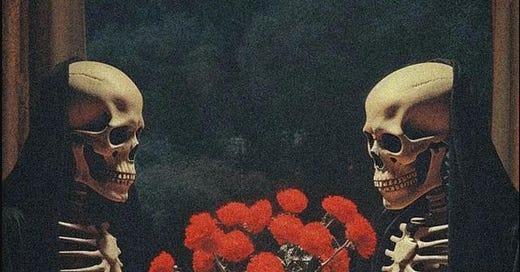Is Samhain a thing of the past?
Rituals, History, and the Meaning of the Halloween/Samhain holiday
Inside: A meditation on the meaning of Halloween and a list of simple ritual suggestions to help you celebrate and make peace with the unknown. Share it with your circles!
What I love about witchcraft, and paganism in general, is that it isn’t a great religion, it’s a local religion. More 3rd house than 9th house. Our practices are about the traditions we create with the people we love. There’s no particular edict we have to follow, or thing we have to believe.
Samhain - the witches’ holiday popularly known as Halloween - is as much a product of literary and artistic innovation as it is of ancient history. As an art witch, the imaginative roots of the holiday delight me.
Since the beginning of recorded history, there have always been festivals around this time of year, but what they mean and why people practice them changes according to the needs of the people.
Samhain, pronounced sow-wen, means “summer’s end” in Irish Gaelic. It arrives as the seasons change and the darkness cometh.
Of course, now, for most of us, the season’s change isn’t so reliable. Hurricane’s cometh, yes. But then perhaps a blistering heat, followed by an autumnal chill, then sprinkling of snow. And most of us hardly notice the dark because of streetlights and the blue glare of our iPhones.
Nevertheless, Samhain has the whiff of the Otherworld about it, bringing danger and delight.
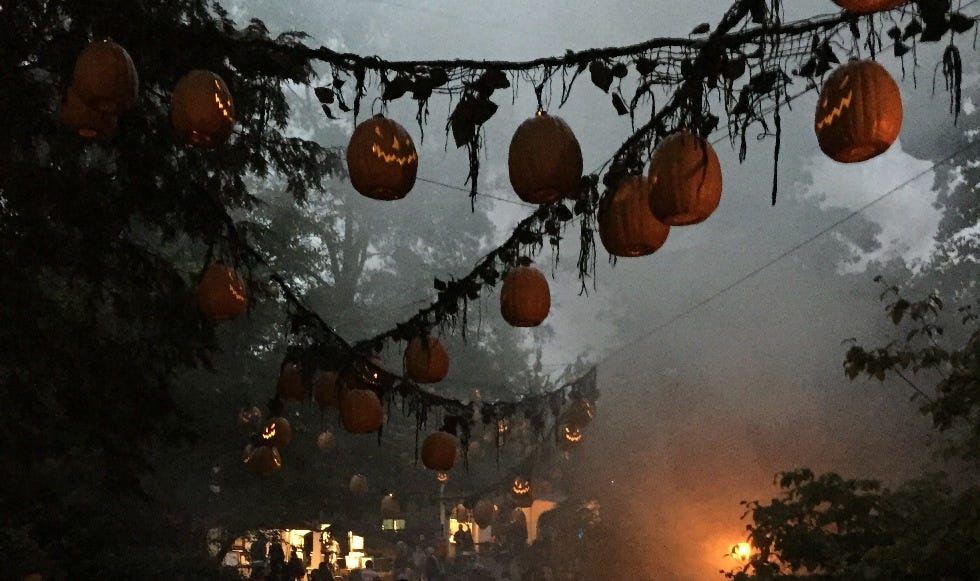
We eat candy and trade lore about how some of it might be poisoned or laced with razor blades. We carve gap-toothed grins into gourds and smash pumpkins. We watch the Headless Horseman throw his jack o’ lantern head across an abandoned bridge. We find scarecrows, witches, skeletons, ghosts and graves have popped up like mushrooms in our neighbor’s yard.
Halloween has a very real material culture for most of us here in the so-called USA. We trick or treat. We dress up in costumes (I went as my friend’s fairy godmother to his Halloween party/wedding ceremony where I officiated), we get cinnamon brooms from Trader Joe’s (I get one every year).
In the United States our revelries struggle to escape the clutches of the consumer culture we’re boiled and bubbled in.
Nevertheless, Samhain is my favorite holiday in the Wheel of the Year, because people get to express what they’re thinking about, what they love, their anxieties about death and loss, all through costume and revelry.
As a witch, my religion is literally creativity. I feel it in all our eight holidays, yet this one is especially fun because the rest of the culture joins in the festivities.
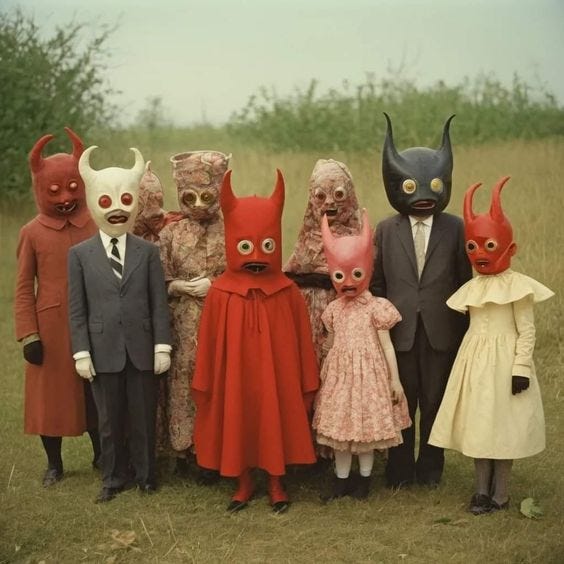
The USA has its own Halloween traditions. When I lived in England, people would dress up as ghouls or goblins, if they dressed up at all. I’d try to explain to them that Halloween costumes don’t have to be scary. At my friend’s wedding/Halloween party some people were zombies, but others were characters from Star Trek. One couple came wrapped in foil and calling themselves “space trash.”
As folklorist, Jack Santino says, on Halloween, “people incorporate ancient symbolic forms and make contemporary statements with them.” Halloween prompts us to play with our fears, so we carve the face of our fear into pumpkins and turnips and let them light our way forward.
Even with the consumerist element of this holiday, one can’t avoid noticing that spirit of the times is still about acknowledging endings, the soul departing the body, the warmth departing the earth.
As Ronald Hutton (scholar of witchcraft) says, one of the main purposes of any religion is to attend to the processes of the human soul. In contemporary witchcraft, and potentially in ancient Celtic practices as well, the soul reincarnates, or moves into the Otherworld and back again, as the Sun itself arrives and departs in day and night.
As you travel around your town this Halloween season pay attention to how the spirit world is represented.

How do devils appear to us and what do they threaten? How is the afterlife depicted in your neighborhood tableaus? What are the masks your friends are wearing telling you as a guise they use to travel between the worlds?
Modernity tries to convince us that time proceeds in a straight line, birth to death, beginning to end. And yet, here we are again at Samhain, a place we have visited together many times before.
Revisiting the holidays again and again, it sure seems like paganism (as with most indigenous cultures) is correct in its view of time. Time is cyclical. The pagan Wheel of the Year is always turning, just like the earth itself.
Frequently, the iconography of this season features fruit and veg. Pumpkins, pomegranates, candy corn, horns of plenty.

We can see how even today ideas related to death, the soul, the afterlife are bound together in our bodies and imaginations with the harvest and the fruits of the earth.
In mythology, fruit is often associated with trips to the Otherworld, Persephone’s pomegranates, the fruits of the fairy world one ought not eat, the apples hanging from the Tree of Knowledge in the Bible.
Samhain was a deadline of sorts for our Northern ancestors. All the crops had to be harvested by this day, and the animals brought in. To miss the deadline was dangerous. It meant that something had gone wrong and you might not make it through the lean months of winter.
The main taproot of the Samhain holiday reaches towards Ireland.

There, Samhain was truly a scary time. The evenings became darker, colder. With the harvest over and the crops in the fields now decaying, the storms arrived. Crows came cawing that someone over the winter would surely die.
For the Irish Gaels, Samhain was the great festival of winter’s beginning, reinvented by the Christians as All Hallow’s Eve as an attempt to missionize the holiday.
The word hallows comes from the Middle English halwe or holy. The Saints were holy people. But so are all the pagan deities.
Before Christian conversion, on Samhain eve, celebrants would gather on the mound of Tlachtga, an earth work said to be named after a druidess who was the daughter of the sun god, Mog Ruith.
In the misty evening, celebrants lit the great Fire of Tlachtga to “summon the priests, the augurs and druids of Ireland… to assemble on Samhain eve in order to consume the sacrifices that were offered to their pagan gods.” [Archaeology Ireland]
All the fires in the kingdom were extinguished on Samhain except for the great Fire of Tlachtga where torches were dipped and then carried out to all the hearths across the land, creating a web of fire throughout the kingdom all from the same source.
Later, during the millennia of Christianity in Northern Europe, the souls of the departed who didn’t make it to heaven, those who still haunted purgatory, were said to come back on this night to petition their loved ones for prayers on their behalf.
One thing that persists in scholarly literature about Halloween is that this is the season of the wandering souls.
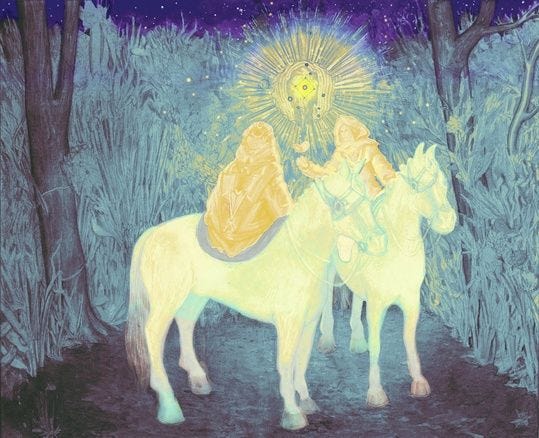
I still like to light candles for them and leave them offerings of food and water.
Scholarly historical literature is crowded with stories of fairies (the souls of the dead) coming abroad on All Hallows Eve and delivering prophecies.
Samhain is a time outside of time, a place where the ordinary world and the Otherworld come together and creatures from both places can intermingle.
Samhain is a turning point, an in-between time and omen day, a sacred threshold between seasons.
The liminal nature of this time of year makes it an especially potent season for divination, contacting the spirits of the departed, seeing into the future, crossing thresholds, taking crossroads, and finding new paths.
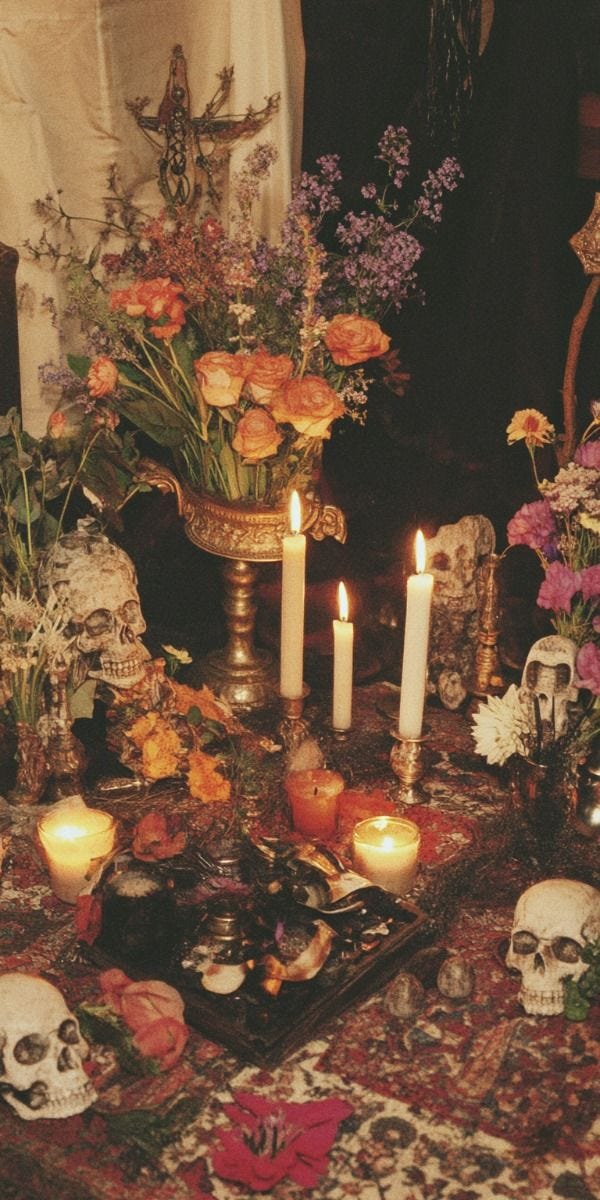
During threshold times, boundaries dissolve. Liminal holidays are times of chaos.
But chaos times are also times when problems we once thought unsolveable can move and shift in surprising directions.
Boundaries between the sexes, between the living and the dead, between the past, the present and the future become thin and porous.
Thresholds times are when anything is possible and everything is connected.

